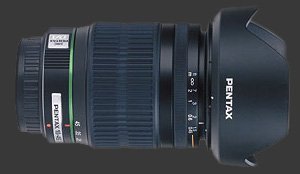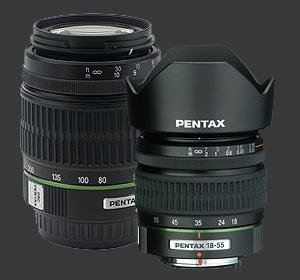DSLR Lens Selection
NOTE: The contents of this article has been superceeded by the more complete DSLR Lens Buying Guide.
A quick look at available lenses shows that there are far more lenses to chose from than DSLR cameras, yet there is a lot less information about them. Most people know by now that kit lenses only get you so far, if anywhere at all. Here we discuss how to create a personalized set of lens. Remember, those are not the only possibilities, so feel free to adapt those to your needs.
Remember that photographs are taken by a whole camera system, including the photographer. A weak link negatively affects the end-result. A poor camera, a poor lens or poor photography skills all result in disappointing pictures. The most frequent mistake of first-time DSLR buyers is to spend most of their budget on a camera body and then buy the only lens that still fits the budget - or worst, the kit lens. The first rule for choosing lenses is to allocate enough money. As it goes for choosing a digital camera, the two most important things to consider are your subjects and your medium.
Lets start with the practical. How frequently are you willing to change lenses? Are willing to do it in the field? The less you are willing to change lenses on location, the more generic your chosen lens will have to be. This often results in some compromise on image quality or versatility. One who does not want to change lenses, should not get more than one. Having too many lenses results in many of them left behind.
Are weight and size important? Too heavy lenses often end-up left behind too. The second rule is to think of how many lenses are you willing to have. Even without a single heavy lens, choosing too many results in higher total weight in the field. Bulk may be equally important for certain environments. Watch out, based on your needs, you may have to exceed the number of lenses you want to have.

Next comes the needs. Needs vary in terms of angle of view, maximum aperture and other features like stabilization, tilt-shift, magnification and focus distance projection. Angle-of-view requirements translate into different focal lengths due to different sensor sizes. Examples here are quoted for the most common crop factors of 1.5 or 1.6. The equivalent need for full-frame DSLR cameras is noted as a tool-tip.
Think about the widest and narrowest angle desired angle of view. This is a personal choice. Some people always want a wider angle-of-view and some people always want to zoom further. If you already have a DSLR and lens, think about how often you are at the widest setting and wished to go wider because you cannot back up further. How about at the long end, how often do you feel the need to get closer? With a 1.5 crop, wide-angle requires 19 mmRoughly equivalent to 28 mm in 35 mm terms or less. Lenses starting from between 24 and 28 mmEquivalent to between 36 and 42 are mostly satisfactory. Ideally, portrait are taken with an 60 to 80 mm lensFrom 90 to 120 in 35 mm equivalence. Distant subjects and wildlife are easier to photograph with 200+ lenses.
Lenses also vary according to maximum aperture. A wider aperture means less depth-of-fieldConsequently a more blurry background and more light gatheringConsequently faster shutter-speeds. Remember that lenses are generally sharpest 2-stops down from their widest. An F4 lens is normally sharpest around F8, while a F2.8 lens around F5.6. An important feature is optical stabilization. It is an available on some lenses. Digital SLRs with built-in stabilization like the Sony Alpha and most Pentax K-series are advantaged since they obtain stabilization on all lenses at no additional cost. Most importantly, image quality varies tremendously between lenses. More expensive lenses are generally of higher quality than cheaper ones of similar specifications.

A set of one lens can be very light and fast to use since lens changes are not required. On the other hand, single lenses with long-zoom ranges are of limited quality and have narrow maximum apertures. Here are various single lens kits:
Canon
Pentax
 |
Wide-to-medium |
 |
Wide-to-medium |
 |
Open wide-to-medium |
 |
Open normal-to-medium |
 |
Wide-to-tele |
Sony
Nikon
With two lenses instead of one, it is easier to cover a wider-range of focal lengths or to cover a similar range with higher quality optics. Of course, the hassle is carrying both lenses and having to swap them. Swapping lenses in the field can be minimized by matching each lens to a different subject. This reduces the risk of getting dust on the camera sensor.
Several wide lenses exist to complement medium lenses. One can be chosen either to complement a quality medium lens or a regular medium-to-tele lens. A lens ending with a medium focal length can be paired with a telephoto lens for extending your reach without compromising quality at medium focal lengths. Here are some good lens pairs:
Canon
Pentax
  |
Wide-to-telephoto Pentax 17-70 F4 SDMPentax 55-300 F4-5.6  |
  |
Open wide-to-tele Pentax 50-135 F2.8 SDM  |
  |
Open normal-to-tele Sigma 24-70 F2.8Sigma 70-200 F2.8 |
Sony
  |
Wide-to-telephoto Sony 16-105 F3.5-5.6Sony 75-300 F4.5-5.6  |
  |
Normal-to-telephoto Sony 24-105 F3.5-4.5Sigma 100-400 F4  |
  |
Open normal-to-tele Sony 24-70 F2.8 Carl ZeissSony 70-200 F2.8 SSM |
Nikon
  |
Open wide-to-medium Nikon 17-35 F2.8 |
  |
Wide-to-tele Nikon 18-55 F3.5-5.6 |
  |
Open normal-to-tele Nikon 24-70 F2.8Nikon 70-200 F2.8 VR |
Please Support Neocamera
All information on Neocamera is provided free of charge yet running this website is a huge endeavor. Purchases made via affiliate links found throughout the site help keep it running and up-to-date. There is no additional cost to you, so please consider buying via these links to our affilates:
Thank you for your support!
Ultra-Wide Angle Lenses
While many general purpose digital lenses start at wide-angles, none are truly ultra-wide lenses. An ultra-wide lens adds an unusual perspective to images, one that does not approach human vision. Note that no ultra-wide lens is stabilized. Thus, stabilizing an ultra-wide lens requires a camera with built-in stabilization. The widest ultra-wide lenses for 1.5X or 1.6X crop sensors start at 10mm, although 12mm is more common start. For full-frame sensors, Sigma has a 12-24mm which gives the widest field-of-view. The next widest field of view come from the Nikkor 14-24 F2.8 full-frame lens and the Zuiko 7-14 F4 Four-Thirds lens.
Updates
2025.11.13

Best Gifts for Photographers in 2025 by Budget
The annual Neocamera Photography Gift Guide updated to 2025. Find great gifts for photographers with any price budget.
2025.07.07

Stellar Photo Recovery Review
Review of Stellar Photo Recovery V12. This Windows and MacOS software can recover photos and videos in a huge number of formats from memory cards, USB drives, SSDs and HHDs.
2025.05.14

Huion Kamvas 13 Gen 3 Review
In-Depth review of the Huion Kamvas 13 Gen 3 Pen Display Tablet for photographers and graphic artists.
2025.01.18

Fujifilm GFX 2025 Lens Roundup
Lens Review roundup of Fujifilm GFX Medium-Format lenses. Quality, performance and handling of the GF20-35mm F/4R WR, GF30mm F/3.5 Tilt-Shift and the GF55mm F/1.7.
2024.11.18

Best 2024 Photography Gifts for Every Budget
Great gifts for photographers and photo enthusiasts selected for every budget among the best products of 2024.
2024.08.07

Eye Protection Tips for Professional Photographers
The four main considerations for professional photographers regarding eyewear.
2024.07.14

Fujifilm X100VI Review
Flagship fixed-lens compact digital camera with a 40 MP sensor and Image-Stabilization, a first for the series. Retro design featuring dual control-dials, plus direct ISO, Shutter-Speed and EC dials. Its hybrid viewfinder can switch between EVF and OVF mode.
2024.05.09

Fujifilm GFX100 II Review
Flagship 102 Megapixels Medium-Format Mirrorless Digital Camera with 8-Stop 5-Axis IBIS, 8 FPS Drive, 8K Video and 400 MP Super-Resolution capture in a weatherproof and freezeproof body with dual control-dials and dual memory-card slots.
2024.04.03

Fujifilm X-T5 Review
Newest Fujifilm flagship boasting a 40 MP APS-C sensor, 5-axis IBIS with 7-stop efficiency, 15 FPS continuous drive, 6.2K Video capture, dual control-dials and dual SDXC UHS-II slots in a sturdy weatherproof and freezeproof body.
2023.11.20

Best Digital Cameras of 2023
Find out which are the Best Digital Cameras of 2023. All the new Mirrorless Digital Cameras from entry-level to high-end professional.
2023.07.10

Fujifilm X-H2 Review
40 Megapixels APS-C Hybrid Mirrorless Digital Camera with 7-stop IBIS. Fastest shutter ever and 8K video capture. Large builtin EVF with 0.8X magnification and 5.8 MP, plus an Eye-Start Sensor. Packed with features and large number of controls in a weatherproof and freezeproof body.
2023.05.07

Sony FE 20-70mm F/4G Review
Review of the unique Sony FE 20-70mm F/4G lens. The optical zoom of this lens spans ultra-wide-angle and medium focal-length coverage, making it one of the most versatile Full-Frame lenses on the market.
2025.11.13
2025.07.07
2025.05.14
2025.01.18
2024.11.18
2024.08.07
2024.07.14
2024.05.09
2024.04.03
2023.11.20
2023.07.10
2023.05.07
NEWS
2025.12.02

Sony Upgrades Alpha 7 to 5th Generation
Digital Camera ○ Lens
2025.11.29

Venus Optics Releases New Zero-D Tilt-Shift Macro Lens
Lens
2025.11.23

Best Digital Cameras of 2025
Digital Camera
2025.11.14

Photography Gift Guide 2025 Edition
2025.11.06

Canon Announces Third-Generation R6 Mirrorless
Digital Camera ○ Lens
2025.10.23

Fujifilm Launches X-T30 III Plus New Wide Zoom
Digital Camera ○ Lens
2025.10.21

Peak Design Unveils Field Plate and Form Straps
2025.10.16

Nikon Unveils Z-Mount DX Lens Duo
Lens
2025.10.16

Venus Optics Unveils Fast Telephoto Prime Lens
Lens
2025.10.01

Think Tank Photo FocusPoint RollTop Backpacks
Bag
2025.09.30

Sony Produces Super Macro GMaster Lens
Lens
2025.09.17

Venus Optics Created First Telephoto Ultra-Macro Lens
Lens



























